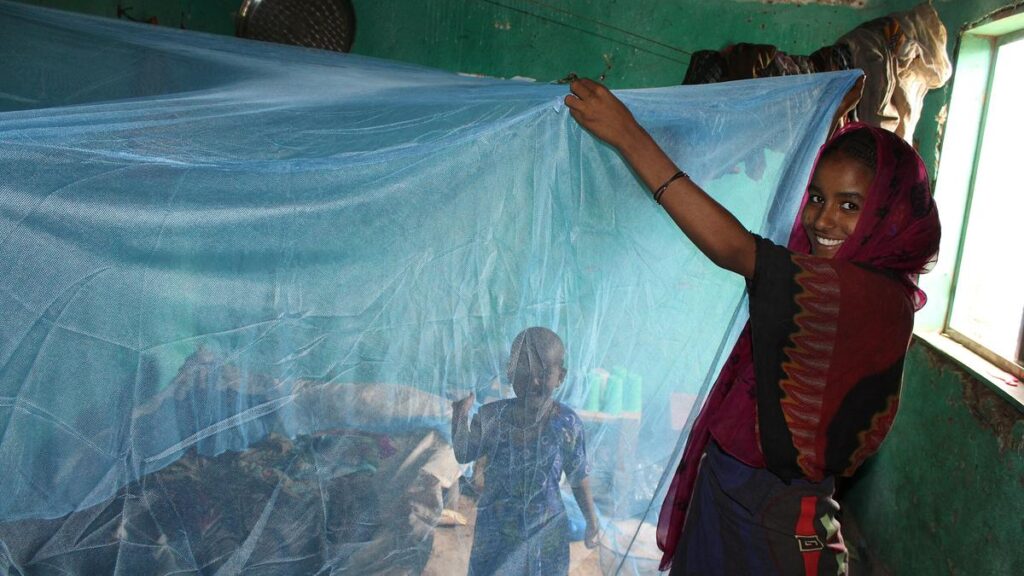
A mother holds up a mosquito net treated with insecticide in Amhara region, Ethiopia, October 2017.
| Photo Credit: Public domain
Researchers reported in Nature on May 22 that they had identified compounds that could target the deadly malaria-causing parasite Plasmodium falciparum during its developmental stages in Anopheles mosquitoes, potentially enhancing efforts to control malaria in an affordable way in the resource-poor areas where it is often endemic.
Per the World Health Organisation (WHO), there were 263 million malaria cases in 2023, up 4.3% from 2022. About 94% of all cases and 95% of all deaths in that year were reported in African countries. Last year, India’s Health Ministry said the country had exited the WHO’s High Burden to High Impact group in 2024, meaning it longer needs to mount intensive efforts to fight the disease. Even so, the National Vector Borne Diseases Control has estimated that “about 95%” of India’s population “resides in malaria endemic areas”.
While the fight against malaria was boosted by the rollout of the WHO-recommended malaria vaccines RTS,S and R21, an important, cost-effective method to stave off malaria infections is to use nets sprayed with insecticide. But according to the new paper, the nets’ impact often levels off when mosquitoes acquire resistance.

To this end, the study has thrown up a suite of specific compounds that can be sprayed on the nets and which the researchers have said will confer both long-lasting and resistance-proof protection against P. falciparum. The root of this effort is the idea that rather than killing mosquitoes, killing the parasites could be more effective.
The researchers have done this by embedding potent, mosquito-stage antiplasmodial drugs in the same polymer fibres that currently carry insecticide. Because these compounds act on P. falciparum, they “avoid potential development of resistance by the vector” and can block transmission even when the insecticide on the net no longer works.
The researchers screened 81 compounds with known antimalarial properties, targeting the early developmental stages of P. falciparum within mosquitoes. These compounds were applied to the bodies of female Anopheles gambiae mosquitoes before they ingested an infected blood meal. Then the researchers assessed the mosquitoes’ parasite burden a week later by counting the number of oocysts, an important phase of the P. falciparum lifecycle when it proliferates into its infectious form.
They shortlisted 22 compounds that mitigated parasite infection, including endochin-like quinolones (ELQs) — antimicrobial agents known for their potent action against many human parasites. ELQ-456 in particular completely blocked parasite infections while ELQ-331 tamped down the infection’s spread.
When mosquitoes landed momentarily on surfaces treated with these compounds, ELQ-456 emerged as the most promising candidate. They also found that when mosquitoes briefly contacted a combination of ELQ-453 and ELQ-613, P. falciparum infections in their bodies were kept to a significant degree from maturing to their infectious forms.

Next, the researchers evaluated ELQ compounds by incorporating them into polyethylene films like those used in insecticide-treated nets. Reportedly, the films effectively inhibited parasite development in both standard and insecticide-resistant mosquito strains even after they were stored for a year in the open.
Finally, the team assessed the potential for these agents to induce antimicrobial resistance in the parasite. Team members found ELQ compounds with similar mechanisms of action didn’t induce resistance across pathways other than their own (a.k.a. cross-resistance). They also raised mutated parasite strains that could resist the agents and reported even their transmissibility was significantly impaired.
The team concluded in its paper that the agents’ “straightforward synthesis is a promising indication of cost-effectiveness, and … with additional process chemistry optimisation, manufacturing-scale synthesis, and bulk net production and procurement, these compounds will be an affordable and effective addition to bed nets even in the current highly competitive market.”
Published – May 25, 2025 05:15 am IST

